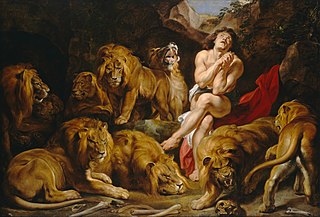Related Research Articles

Pope Cornelius was the bishop of Rome from 6th or 13th March 251 until his martyrdom in June 253. He was pope during and following a period of persecution of the church, while a schism occurred over how repentant church members who had practiced pagan sacrifices to protect themselves could be readmitted to the church. He agreed with Cyprian of Carthage that those who had lapsed could be restored to communion after varying forms of Reinitiation and Penance. This position was in contrast to the Novatianists, who held that those who failed to maintain their confession of faith under persecution would not be received again into communion with the church. This resulted in a short-lived schism in the Church of Rome that spread as each side sought to gather support. Cornelius held a synod that confirmed his election and excommunicated Novatian, but the controversy regarding lapsed members continued for years.

Seshat was the ancient Egyptian goddess of writing, wisdom, and knowledge. She was the daughter of Thoth. She was seen as a scribe and record keeper; her name means "female scribe". She is credited with inventing writing. She also became identified as the goddess of sciences, accounting, architecture, astronomy, astrology, building, mathematics, and surveying.

Bahram II was the fifth Sasanian King of Kings (shahanshah) of Iran, from 274 to 293. He was the son and successor of Bahram I. Bahram II, while still in his teens, ascended the throne with the aid of the powerful Zoroastrian priest Kartir, just like his father had done.

The Forty Martyrs of England and Wales or Cuthbert Mayne and Thirty-Nine Companion Martyrs are a group of Catholic, lay and religious, men and women, executed between 1535 and 1679 for treason and related offences under various laws enacted by Parliament during the English Reformation. The individuals listed range from Carthusian monks who in 1535 declined to accept Henry VIII's Act of Supremacy, to seminary priests who were caught up in the alleged Popish Plot against Charles II in 1679. Many were sentenced to death at show trials, or with no trial at all.

Kōsa, also known as Hongan-ji Kennyo, was the 11th head of the Hongan-ji in Kyoto, and Chief Abbot of Ishiyama Hongan-ji, cathedral fortress of the Ikkō-ikki, during its siege at the end of the Sengoku period. He engineered many alliances, and organized the defenses of the cathedral to the point that most at the time considered Ishiyama Hongan-ji to be unbreachable.

A relief airport or reliever airport is an airport that is built or designated to provide relief or additional capacity to an area when the primary commercial airport(s) requires additional capacity, on a long-term or temporary basis. Reliever airports may also relieve the need for capacity by relocating non-jet general aviation activity from a commercial airport to a different facility. By removing aircraft with lower capacities and slower speeds, the commercial service airport is able to operate more flights with larger aircraft and handle more passengers increasing the efficiency with minimal additional cost in facilities. This also spreads out the aircraft over a wider area generally improving air traffic in the entire community.

The Eighty-five Martyrs of England and Wales, also known as George Haydock and Eighty-four Companion Martyrs, are a group of men who were executed on charges of treason and related offences in the Kingdom of England between 1584 and 1679. Of the eighty-five, seventy-five were executed under the Jesuits, etc. Act 1584.

John Harewell was a Bishop of Bath and Wells in medieval England.
Richard Fletcher was a Church of England priest and bishop. He was successively Dean of Peterborough (1583–89), bishop of Bristol (1589–93), Bishop of Worcester (1593–95) and Bishop of London (1595–96).

Daniel is the main character of the Book of Daniel. According to the Hebrew Bible, Daniel was a noble Jewish youth of Jerusalem taken into captivity by Nebuchadnezzar II of Babylon, serving the king and his successors with loyalty and ability until the time of the Persian conqueror Cyrus, all the while remaining true to the God of Israel. While some conservative scholars hold that Daniel existed and his book was written in the 6th century BCE, most scholars agree that Daniel is not a historical figure and that much of the book is a cryptic allusion to the reign of the 2nd century BCE Hellenistic king Antiochus IV Epiphanes.

Nicholas Horner was an English Roman Catholic layman, hanged, drawn and quartered because he had "relieved and assisted" Christopher Bales, a seminary priest. A tailor by trade, he was charged with making a jerkin for a priest. Horner maintained that the customer was a stranger and he didn't know who he was. Horner is recognized as a Catholic martyr, beatified in 1987.
Richard Martin was an English martyr. A layman, Martin was charged with being a "receiver and maintainer of priests" for having bought supper for Robert Morton, a priest.
Richard Marshall D.D. was an English clergyman and academic administrator at the University of Oxford.

Little Big Horn is a 1951 American Western film written and directed by Charles Marquis Warren starring Lloyd Bridges, John Ireland and Marie Windsor.
John Longland was a 16th century English priest.
Nathaniel Lye, D.D. was an English Anglican priest.
Richard Remington was an English priest in the late 16th and early 17th centuries.
The Venerable Richard Strete was an Anglican priest in England during the 16th century.
Richard Walker (1501–1567) was an English priest in the 16th century.
References
- ↑ Wainewright, John. "Ven. Richard Leigh." The Catholic Encyclopedia. Vol. 9. New York: Robert Appleton Company, 1910. 3 Feb. 2014
- 1 2 "Venerable Richard Flower (Lloyd)", Lives of the English Martyrs, vol.1, (Edwin Burton and J.H. Pollen, eds.), Longmans, Green and Co., 1914, p. 425
 This article incorporates text from this source, which is in the public domain .
This article incorporates text from this source, which is in the public domain .